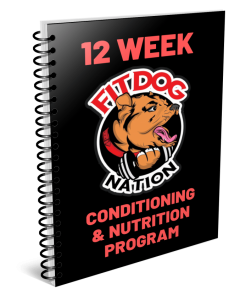
So you got a new puppy and you’re excited to develop and nurture them into the best they can possibly be. But you want to know what age you can start conditioning?
Before we dive in, it’s important to remember the purpose of exercise conditioning. Essentially, its to develop your dogs fitness. Our definition of fitness is the ability for a dog to perform a specific task or skill. All tasks take effort, no matter what it is, whether its fetch, treadmill or weight pulling.
They key to conditioning young dogs and all dogs for that matter isn’t only necesarily what activity you’re doing but what intensity you are performing the activity at.
Most dogs mature at the age of 2 years old. This is the age their anatomy and physiology are fully developed and can withstand maximum levels of intensity. Until then, we recommend that exercise conditioning is no more than 50-70% of their maximum effort.
Recommended Intensity defined
Intensity levels can be rated at either low, medium or high intensity. As all dogs are individuals and all activities are different, you need to use common sense but here is an example of intensities based on the activity of treadmill work.
Low intensity treadmill work: Involves your dog walking at a pace that’s between 10-40% of their maximum effort.
Moderate intensity is defined as your dog exercising at 40-60% of their maximum effort such as a fast walk or jog.
High intensity treadmill work would involve your dog working at 80%+ of their maximum effort such as a fast run or sprint.
but WHAT ABOUT STUNTING MY PUPS GROWTH?
We are happy to inform you that the commonly held belief of stunting a pups growth with exercise is a myth. Sorry to offend anyones beliefs but this is an old wives tale that developed in the 60’s and 70’s in response to the new sport of human body building in the USA. This belief was then adopted in dog communities who incorrectly applied it to do dogs. Since then this myth has been debunked and various scientific research papers have proven this theory false. But do not take our word for it, read the references at the end of this article.

SO, WHERE DO I START?
Eight weeks old is when training should start. Remember your goal is not only to get your dog fit but also to introduce them to the world they are about to grow up in. That includes the environments they will be training in, the equipment they will be using and the animals they will be around. Initial exercise conditioning should start with positive reinforcement of the equipment to be used. You can start this the moment your new puppy arrives in your home. Do not wait until they are 6 months or older to start. Get started right away.
Why?
Simple, the earlier the better. Dogs learn from repetition and consistency. A dog that learns to walk on a Slatmill at 8 weeks and has consistent training will be set for long term success. We start by teaching puppies basic obedience skills on the treadmill such as sit and down. This prepares your puppy for treadmill manners later on when they are able to work harder on the mill. By starting these behaviors early you will help your dog retain the behaviors over the long term because these months are their formative months for learning.
TOP TIPS
Remember every dog is an individual, use your common sense. Make sure you do not do any high intensity activities (80%+) until your dog is at least 2 years old. You can start exercise conditioning from 8 weeks old but make sure its no more than 50%-70% of their maximum effort. It should also be based around fun, informative sessions that will help build your dogs behavior and trainability.
 P.S. Get a custom made 12 Week Conditioning and Nutrition program for your pup.
P.S. Get a custom made 12 Week Conditioning and Nutrition program for your pup.
Comment below and let us know your thoughts!
For help and advice feel free to contact support@fitdognation.com
Keep Them FIT,
FITDOG NATION
References
Faigenbaum, A.D., W.J. Kraemer, B. Cahill, J. Chandler, J. Dziaos, L.D. Elfrink, E. Forman, M. Gaudiose, L. Micheli, M. Nitka, & S. Roberts (1996). “Youth resistance training: Position statement paper and literature review.” Strength Cond. J. 18(6): 62–75.
Azeem, K., Al Ameer, A. (2010). “An Effect of weight training on sprinting performance, flexibility and strength.” British Journal of Sports Medicine 44:i22.
Barr MJ, Sheppard JM, Gabbett TJ, and Newton RU. (2014) “Long-term training-induced changes in sprinting speed and sprint momentum in elite rugby union players.” J Strength Cond Res 28: 2724- 2731.